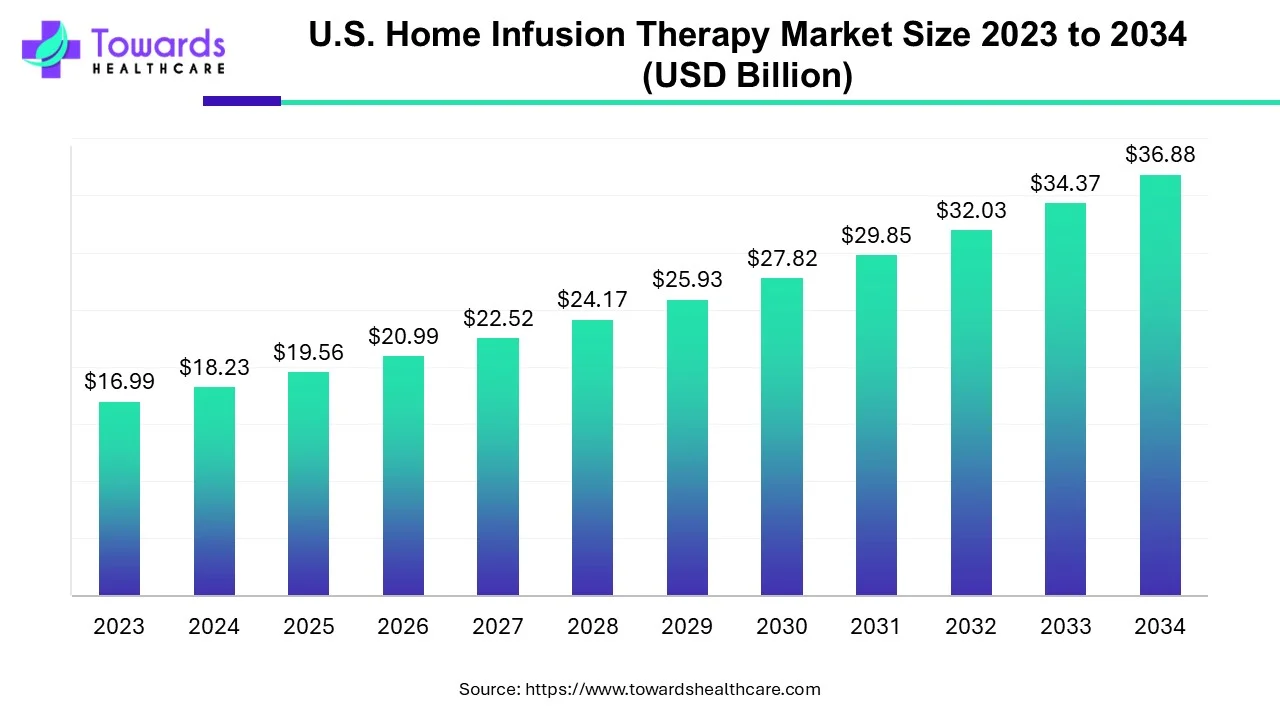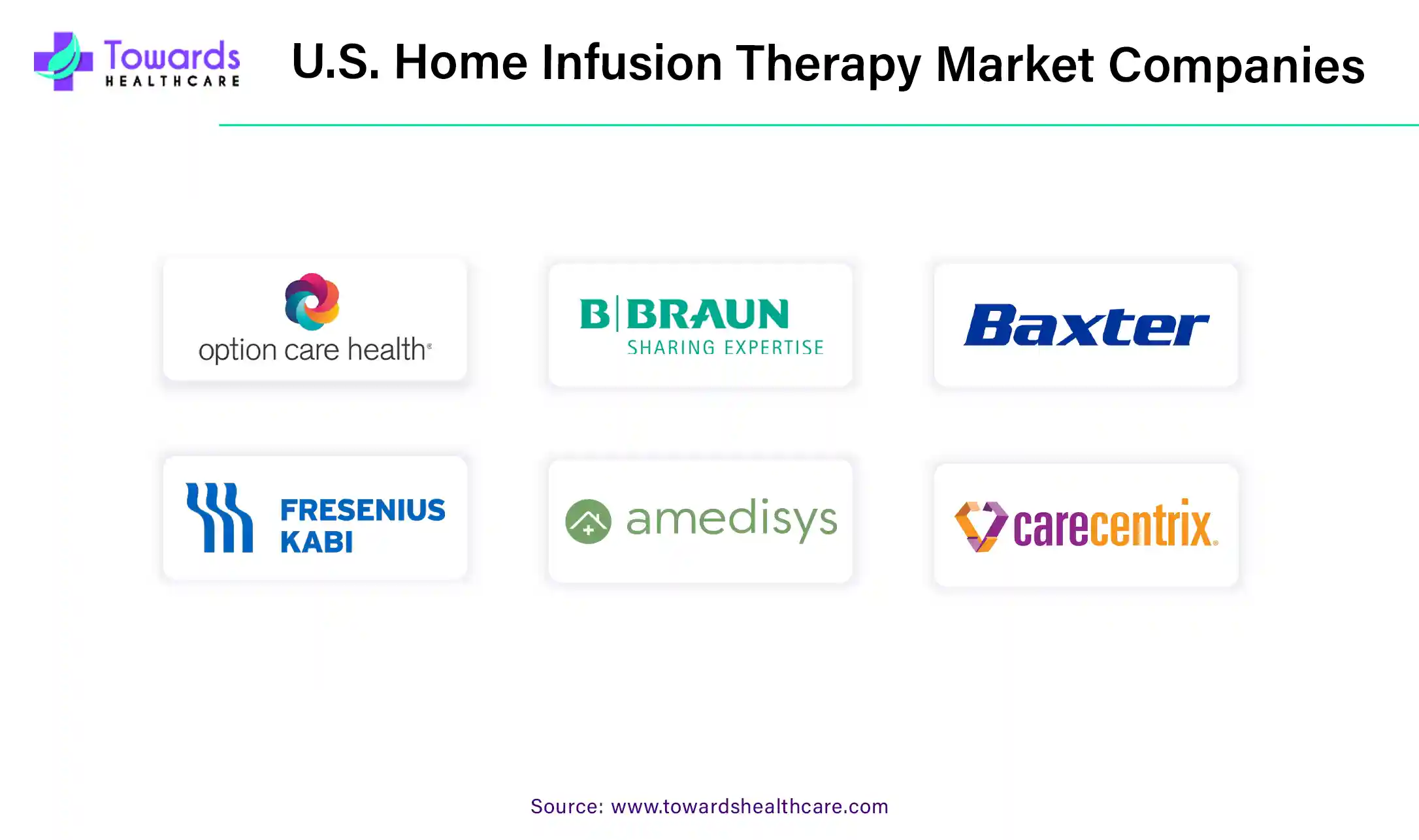April 2025

.webp)
Principal Consultant

Reviewed By
The U.S. home infusion therapy market is predicted to expand from USD 19.56 billion in 2025 to USD 36.88 billion by 2034, growing at a CAGR of 7.3% during the forecast period from 2025 to 2034.

According to the American Cancer Society, approximately 1.8 million people were diagnosed with cancer, with over 600,000 people expected to die as a result of this challenging disease. Home infusion allows patients to manage cancer treatment actively, giving them greater control.
In 2020, the National Home Infusion Foundation Trends 2020 Report estimated that the fascinating world of home and specialty infusion caters to over 3.2 million patients annually. The COVID-19 pandemic hit a pause on elective surgeries, causing a dip in the need for follow-up home care. Thanks to cost-cutting by slashing inpatient stays and a buffet of infusion device options. Home infusion therapy (HIT) takes the healthcare party directly to a patient's doorstep at home, nursing home, hospital or outpatient clinic. But, also, a knowledge gap looms between the home infusion experts and the clinicians, potentially leading to less-than-stellar outcomes. Let's bridge that gap for optimal therapeutic adventures.
U.S. Home infusion therapy is like bringing the hospital to your home! It's a specialized healthcare service where patients receive medications through a needle or catheter at home instead of going to a medical facility. This method is often used for conditions requiring ongoing treatments, like infections, chronic illnesses or pain management. A trained healthcare professional usually administers the infusions, ensuring patients can comfortably manage their treatment in the familiar environment of their own homes. It offers convenience and personalized care, making the healing process a bit easier.
The COVID-19 pandemic had challenges and opportunities for the U.S. home infusion therapy market. On the downside, the initial disruptions in healthcare systems worldwide affected the regular flow of services, including U.S. home infusion therapy. Patients were hesitant due to safety concerns and healthcare resources were strained. However, on a positive note, the pandemic emphasized the importance of home-based care and many patients and healthcare providers turned to home infusion therapy to minimize exposure. Telehealth services also played a crucial role in monitoring and managing treatments remotely. The flexibility and reduced infection risks associated with home infusion gained prominence, leading to a renewed appreciation for this personalized and patient-friendly approach to healthcare. As we adapt to a post-pandemic world, the home infusion therapy market is expected to grow as vital to accessible and patient-centered healthcare.
Internationally, the idea of getting cancer treatments at home has proven safe and effective for various patients and treatments. Around 5% to 10% of global patients opt for home administration, with even intensive chemotherapy being successfully done at home. It offers comparable care and enhances the overall experience for patients and caregivers while being more cost-effective. In the United States, the practice of delivering cancer drugs at home is not common. This reluctance is primarily due to ingrained preferences for outpatient or inpatient treatments among healthcare professionals and patients. Additionally, established health insurance and drug reimbursement policies contribute to this trend.
For Instance,
As cancer becomes more common, some people now need chemotherapy at home. This means getting the necessary treatment in their homes instead of going to a hospital. It helps make the process more convenient for patients. In 2020, nearly 43% of cancer diagnoses in men were attributed to prostate, lung and colorectal cancers. Similarly, for women, breast, lung and colorectal cancers made up about half of all new cancer cases in that year. It's worth noting that the adoption of home infusion therapy has been on the rise, contributing to increased care for individuals dealing with these prevalent cancers.
Report by the American Cancer Society

U.S. home infusion therapy has become increasingly popular, especially in cancer treatment, as it involves delivering medications directly into a patient's bloodstream through intravenous (IV) infusion within the comfort of their home. Several key factors drive this shift. The patients appreciate the comfort and convenience of receiving treatment at home, bypassing the need for frequent hospital or clinic visits. This enhances the overall quality of life for individuals undergoing prolonged or regular therapies and allows for a more personalized care approach. Healthcare professionals can better tailor the schedule and dosage of medications to suit each patient’s needs and lifestyle.
Additionally, regarding comfort and personalization, U.S. home infusion therapy reduces healthcare costs in the long run. Although there may be initial setup expenses, the overall financial burden is alleviated by fewer hospital visits, leading to decreased transportation costs, less strain on healthcare facilities and potentially lower insurance expenses. Technological advances are crucial, making administering complex therapies at home easier. Portable infusion pumps and remote monitoring capabilities enable healthcare providers to closely track a patient's progress without constant in-person visits.
Furthermore, U.S. home Infusion therapy empowers patients to manage their treatment actively, fostering an increased sense of control. This empowerment can have positive effects on the psychological and emotional well-being of individuals grappling with cancer. Moreover, avoiding infections is a significant benefit, considering hospitals can be breeding grounds for pathogens. Home infusion minimizes the risk of exposure to harmful infections, which is particularly crucial for patients with compromised immune systems, such as those undergoing cancer treatment. While the prevalence of cancer has fueled the growth of the home infusion therapy market, its appeal extends beyond oncology to encompass other chronic conditions requiring ongoing intravenous treatments. This trend underscores a broader shift towards patient-centric healthcare, aiming to enhance medical interventions' effectiveness and overall experience.
Imagine a world where receiving medical treatments becomes more comfortable and efficient. Elastomeric devices, essentially flexible and stretchy gadgets, are being innovated to make home infusion therapies easier to adopt. These devices use intelligent materials that can adapt to the body's movements, providing a user-friendly experience for patients undergoing infusion therapies. The goal is to enhance comfort and convenience and encourage more people to embrace these important medical treatments.
The Elastomeric Pump Device, offered by Balmers Pump, serves diverse purposes in drug delivery, catering to needs such as administering antibiotics, chemotherapeutic drugs, analgesics and local anesthetics. Its applications span various medical fields, including postoperative analgesia, ambulatory chemotherapy and outpatient parenteral antibiotic therapy (OPAT). Post-surgery, these pumps effectively manage acute pain and improve the patient's quality of life by maintaining optimal drug plasma levels. Ambulatory chemotherapy enables patients to receive infusions comfortably at home, ensuring adherence to treatment regimens without disrupting daily routines. Additionally, Elastomeric Pumps contribute to the growth of outpatient parenteral antibiotic therapy (OPAT) services, offering cost-effective, user-friendly solutions that enhance patient mobility and streamline the overall care process. As a result, these applications contribute to the global expansion of the market for Elastomeric Pump Devices.
The U.S. home infusion therapy market faces a friendly challenge with healthcare policies. Currently, these policies mainly support treatments in hospitals or clinics, making it a bit tricky for home infusion to become more widespread. The rules and how insurance pays for things favor treatments in healthcare buildings. These policies might only partially show how excellent home infusion therapy is. We need our healthcare rules to be more open and friendly towards this convenient way of getting treatment at home. Our healthcare guidelines need an update to fully embrace the great possibilities of home infusion therapy.
The geographical landscape for the U.S. home infusion therapy market varies, with growth observed in both developed and developing regions. In developed countries like the United States and Western European nations, an aging population and a preference for home-based healthcare contribute to market expansion. Developing regions, driven by improving healthcare infrastructure and rising awareness, also show increasing adoption of home infusion services. Regulatory frameworks, reimbursement policies and each region's healthcare landscape may influence market dynamics.
For Instance,

The U.S. home infusion therapy market is experiencing notable growth in Asia. Factors such as a rising geriatric population, increasing prevalence of chronic diseases and improving healthcare infrastructure contribute to expanding home infusion services. Countries like Japan, China, India and Australia are key players in this market, with a growing awareness of the benefits of home-based healthcare. Regulatory frameworks and reimbursement policies play pivotal roles in shaping the market dynamics across different countries in the Asia Pacific region.
The competitive landscape for the U.S. home infusion therapy market. Key factors influencing competition include service range, geographical coverage and technological integration for seamless patient care. Market dynamics are also shaped by regulatory compliance, partnerships with healthcare providers, and advancements in remote monitoring technologies. Continuous innovation and a focus on patient-centric solutions are critical for companies aiming to gain a competitive edge in this evolving healthcare segment.

By Product
By Application
April 2025
March 2025
March 2025
March 2025